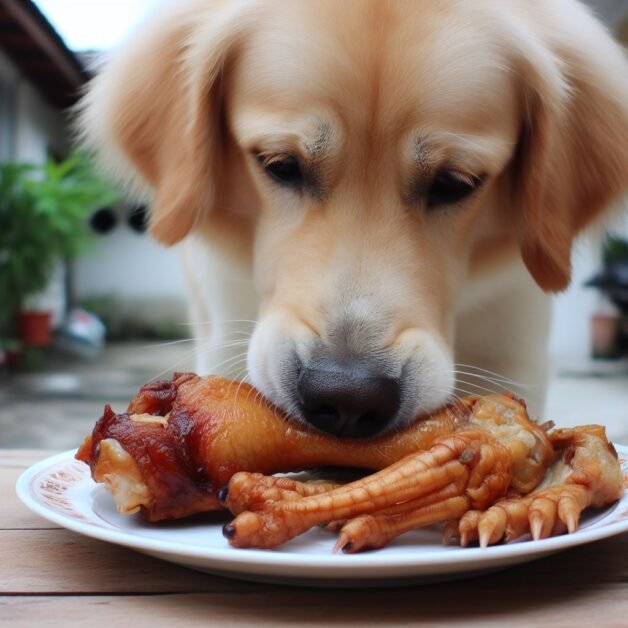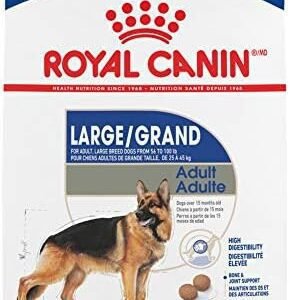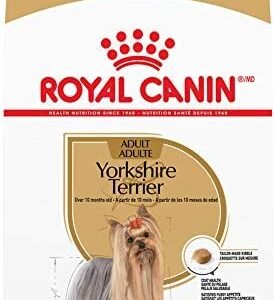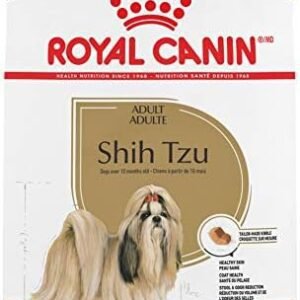Dogs, our loyal companions, often share not only our homes but also our meals. The sheer joy in their eyes when they beg for a bite of whatever we’re eating is hard to resist. As responsible pet parents, it’s essential to be vigilant about what we feed our canine friends. While some human foods are safe and even beneficial for dogs, others can be harmful or downright dangerous.

Table of Contents
The Curious Case of Chicken Feet
When you think about dog food, chicken is probably one of the first ingredients that come to mind. It’s a staple in many commercial dog foods, and dogs seem to have an innate love for the taste of chicken. But what about chicken feet? These bony, clawed extremities may not be the first choice for most human diners, but they are a delicacy in many cultures around the world.
Chicken feet are often used in various culinary traditions, from soups and stews to dim sum dishes. They are prized for their unique texture and collagen content, which can lend a silky richness to broths and sauces. However, when it comes to sharing this delicacy with our four-legged friends, a few important questions arise.
The Quest for Safe and Healthy Doggy Delicacies
As dog owners, we want the best for our pets. We carefully select their food, considering their nutritional needs, allergies, and sensitivities. We may wonder if chicken feet are a safe and healthy addition to our dog’s diet or if they should remain an exclusive human indulgence.
In this blog post, we aim to provide you with a comprehensive guide to making an informed decision about whether to include chicken feet in your dog’s menu. We will explore the potential benefits and drawbacks, discuss the nutritional aspects, and offer guidance on portion sizes. Additionally, we’ll address what to do if your dog happens to nibble on parts of chicken feet that are not edible or safe for them.
Unraveling the Mystery: Can Dogs Eat Chicken Feet?
The central question we are here to answer is whether dogs can safely consume chicken feet. To do that, let’s first break down the components of chicken feet and evaluate their suitability for our furry friends.
- Nutritional Value of Chicken Feet: Chicken feet are a rich source of nutrients, including protein, collagen, and essential minerals such as calcium and phosphorus. These components can potentially offer health benefits to dogs, but there are also some considerations to keep in mind.
- Pros of Feeding Chicken Feet to Dogs: In this section, we will delve into the potential advantages of incorporating chicken feet into your dog’s diet. From promoting joint health to enhancing skin and coat condition, there are several reasons why some dog owners opt for this unconventional treat.
- Cons and Risks: Not all that glitters is gold, and the same holds true for chicken feet as a dog treat. We will explore the possible risks and downsides, such as choking hazards, excessive fat content, and the importance of moderation.
- Portion Control and Preparation: Like any other treat or food item, moderation is key. We will provide guidelines on how to prepare and serve chicken feet to your dog while ensuring their safety and well-being.
- Common Concerns and Misconceptions: Along the way, we’ll address some common concerns and misconceptions surrounding chicken feet for dogs. From myths about splintering bones to the belief that dogs can eat any part of the chicken, we’ll separate fact from fiction.
- What to Do If Your Dog Ingests Inedible Parts: Accidents can happen, and curious dogs might consume parts of chicken feet that are not safe for them. We’ll offer advice on how to handle such situations and when it’s essential to seek veterinary care.
By the end of this article, you’ll have a comprehensive understanding of whether chicken feet can be a part of your dog’s diet and how to navigate this unique culinary choice for your furry friend. So, let’s embark on this flavorful journey together and uncover the delicious truth about dogs and chicken feet.
Can Dogs Eat Chicken Feet? Unraveling the Nutritional Puzzle
Is chicken feet safe for dogs to devour, and could they possibly relish the taste of this unusual delicacy? In this section, we will explore the safety, nutritional value, and potential benefits and drawbacks of feeding chicken feet to your canine companion.
The Safety of Chicken Feet for Dogs
First and foremost, let’s address the most crucial question: Is chicken feet safe for dogs to consume? The good news is that chicken feet are generally considered safe for dogs. Unlike some human foods that can be toxic to our four-legged friends, chicken feet don’t fall into that category.
Dogs are natural carnivores, and chicken feet provide them with a source of animal protein that aligns with their dietary needs. Moreover, the bones in chicken feet are small and soft, making them less likely to splinter and pose a choking hazard compared to larger, harder bones. However, it’s essential to take precautions, as we’ll discuss later in this section.
Nutrition Facts of Chicken Feet
To understand whether chicken feet can be a valuable addition to your dog’s diet, let’s break down the nutritional content of this peculiar treat. Below is a nutrition facts table for chicken feet:
| Nutrient | Amount per 100 g |
|---|---|
| Calories | 215 kcal |
| Fat | 14.6 g |
| – Saturated fat | 4.1 g |
| – Polyunsaturated fat | 2.9 g |
| – Monounsaturated fat | 5.8 g |
| Cholesterol | 87 mg |
| Sodium | 69 mg |
| Potassium | 132 mg |
| Carbohydrate | 0.2 g |
| Protein | 19.4 g |
| Vitamin A | 12 mcg |
| Vitamin C | 0 mg |
| Vitamin D | 0.3 mcg |
| Calcium | 37 mg |
| Iron | 0.4 mg |
| Folate | 57 mcg |
Nutritional Benefits of Chicken Feet for Dogs
Chicken feet may not be an everyday dog treat, but they do offer some nutritional benefits:
- Rich in Protein: With an impressive protein content, chicken feet can support your dog’s muscle development and maintenance.
- Source of Collagen: Collagen is essential for healthy joints and skin. Chicken feet are packed with this protein, which can help maintain your dog’s joint health and contribute to a shiny coat.
- Calcium and Phosphorus: These minerals are crucial for bone health and development, and chicken feet provide a good balance of both.
- Vitamins: Chicken feet contain various vitamins, including vitamin A, which supports vision and immune health, and vitamin E, an antioxidant that helps protect cells.
- Low in Fat: While they offer great taste and nutrition, chicken feet are relatively low in fat, making them suitable for dogs that need to maintain a healthy weight.
Drawbacks of Feeding Chicken Feet to Dogs
As with any food, there are some potential drawbacks to consider when feeding chicken feet to your dog:
- Risk of Choking: Although chicken feet bones are less likely to splinter than larger bones, there is still a risk of choking, especially if your dog tries to swallow them whole. Always supervise your dog when they’re enjoying this treat.
- Caloric Content: Chicken feet are moderately calorie-dense, so overfeeding can lead to weight gain. It’s crucial to factor the calories from chicken feet into your dog’s daily intake.
- High in Protein: While protein is essential, an excess of it can strain the kidneys, so be cautious about overindulging your dog in chicken feet.
- Not a Complete Diet: Chicken feet should be considered a supplemental treat rather than a complete meal. They should complement your dog’s primary diet, which should be balanced and formulated to meet their specific nutritional requirements.
What Are the Risks of Feeding Chicken Feet to Dogs?
Feeding your dog chicken feet can be a rewarding experience, but it’s essential to be aware of the potential risks and hazards associated with this treat. In this section, we will explore the possible adverse reactions, food allergies, and other concerns that can arise when dogs consume chicken feet.
Food Allergies and Intolerance
Just like humans, dogs can develop food allergies and intolerances, and chicken feet are no exception. While food allergies to chicken meat itself are relatively rare, some dogs may have sensitivities to specific proteins or components found in chicken feet. These sensitivities can manifest as adverse reactions, which can vary from mild to severe.
Short-Term Signs of Food Intolerance
If your dog is sensitive to chicken feet or any of their components, you may observe short-term signs of food intolerance, including:
- Gastrointestinal Distress: This can include symptoms such as vomiting, diarrhea, or upset stomach. If your dog experiences these symptoms after consuming chicken feet, it may indicate a sensitivity to certain proteins or fats present in the treat.
- Excessive Gas: Some dogs may develop gas or flatulence as a response to dietary changes or specific ingredients. If you notice increased gas after feeding chicken feet, it could be a sign of intolerance.
- Lethargy: In some cases, dogs may become lethargic or exhibit a lack of energy after consuming a food to which they are sensitive.
Potential Hazards in Chicken Feet
While chicken feet offer several nutritional benefits, there are certain components that can pose risks to dogs:
- Bones: While chicken feet bones are small and less likely to splinter than larger bones, there is still a potential choking hazard, especially if your dog attempts to swallow them whole. Always supervise your dog when they’re enjoying chicken feet to prevent any accidents.
- High Fat Content: Chicken feet are relatively high in fat, which can lead to gastrointestinal upset or pancreatitis in dogs if consumed in excess. Ensure that you factor in the fat content from chicken feet when planning your dog’s overall diet.
Allergic Reactions to Chicken Feet
In some cases, dogs can experience allergic reactions to specific proteins or components found in chicken feet. These reactions can range from mild to severe and may include:
- Skin Irritation: Signs may include itching, redness, hives, or rashes.
- Digestive Issues: In addition to gastrointestinal distress, allergic reactions can manifest as vomiting or diarrhea.
- Respiratory Symptoms: Some dogs may exhibit coughing, sneezing, or difficulty breathing.
- Swelling: Swelling of the face, lips, or tongue can occur in severe allergic reactions and requires immediate veterinary attention.
- Anaphylaxis: Although rare, severe allergic reactions can lead to anaphylaxis, a life-threatening condition that requires immediate emergency care. Symptoms may include extreme difficulty breathing, collapse, or loss of consciousness.
Signs and Symptoms of Adverse Reactions
If you suspect that your dog is experiencing adverse reactions to chicken feet, it’s crucial to be vigilant and watch for signs such as:
- Repeated vomiting or diarrhea
- Excessive drooling
- Lethargy or weakness
- Difficulty breathing
- Swelling of the face or body
- Seizures
If you observe any of these symptoms, contact your veterinarian immediately. It’s also a good idea to consult your vet before introducing any new treat or food into your dog’s diet, especially if your dog has a history of food allergies or sensitivities.
In conclusion, while chicken feet can be a safe and nutritious treat for many dogs, it’s essential to be aware of the potential risks and hazards. Monitor your dog for any signs of food intolerance, allergies, or adverse reactions when introducing chicken feet or any new food item. Always exercise caution, provide moderation, and prioritize your dog’s health and well-being when selecting treats for your furry friend. In the following sections, we will delve into portion control and offer guidance on how to safely incorporate chicken feet into your dog’s diet.
How to Feed Chicken Feet to Your Dog and Make It More Enjoyable for Them
Feeding chicken feet to your dog can be a delightful experience for both you and your furry friend. In this section, we’ll explore various ways to offer chicken feet to your dog, making mealtime an enjoyable and nutritious adventure.
Fresh or Frozen Treat
One of the simplest ways to introduce chicken feet to your dog’s diet is by offering them as a fresh or frozen treat. Many pet stores and butchers carry chicken feet, which are typically sold frozen. Here’s how you can make it an enticing treat:
- Thawing: If you’ve purchased frozen chicken feet, thaw them in the refrigerator until they are soft enough for your dog to chew on safely.
- Supervision: Always supervise your dog while they enjoy their chicken feet to ensure they don’t attempt to swallow large pieces or encounter any choking hazards.
- Occasional Treat: Consider chicken feet as an occasional treat rather than a daily staple. This helps avoid over consumption of fat and ensures that your dog enjoys a balanced diet.
Food Topper or Mixer
Chicken feet can also be incorporated into your dog’s regular meals as a food topper or mixer. This adds flavor, texture, and nutrition to their food. Here’s how to do it:
- Prepare the Chicken Feet: If you have access to fresh chicken feet, you can cook them by boiling or steaming until they are fully cooked. Remove any small bones or sharp parts that could pose a choking hazard.
- Portion Control: Depending on your dog’s size and dietary needs, chop the chicken feet into appropriately sized pieces. Small dogs may require smaller portions.
- Mix with Dog Food: Simply add the chopped or shredded chicken feet to your dog’s kibble or wet food. Mix it well to ensure your dog gets a taste of chicken feet with every bite.
Homemade Treats and Snacks
For those looking to get creative in the kitchen and pamper their pups with homemade treats, chicken feet can be an exciting ingredient. Here are some ideas for making delicious and nutritious homemade treats and snacks for your dog using chicken feet:
- Chicken Feet Popsicles: Create refreshing chicken feet popsicles by blending chicken feet with some chicken broth or water and freezing the mixture in ice cube trays or silicone molds. These icy delights are perfect for hot summer days.
- Chicken Feet Smoothies: Blend chicken feet with other dog-friendly ingredients like carrots, pumpkin, or sweet potatoes to make a nutrient-packed smoothie for your dog. You can add some ice cubes for extra refreshment.
- Chicken Feet Muffins: Craft chicken feet muffins by mixing finely ground chicken feet with dog-safe ingredients like oat flour, rolled oats, applesauce, eggs, and a touch of honey. Bake them into pup-friendly muffins for a tasty snack.
- Chicken Feet Broth: Simmer chicken feet to make a rich and savory broth. This broth can be poured over your dog’s regular food to enhance its flavor and moisture content.
- Stuffed Chicken Feet: Stuff chicken feet with dog-friendly ingredients like peanut butter or cream cheese, then freeze them for a delightful and interactive treat.
Exploring Recipes and Ideas
Chicken feet are a popular treat for dogs, as they are rich in glucosamine and chondroitin, which can help with joint health and dental hygiene. There are different ways to prepare chicken feet for dogs, such as boiling, baking, dehydrating, or air-drying. Here are some recipes and tips for making chicken feet for your dog:
- Boiling: This is the simplest method, as you only need chicken feet and water. You can boil the chicken feet for 15 minutes, then drain and let them cool down. You can give them to your dog fresh or frozen, or you can dehydrate them in the oven or a dehydrator for longer shelf life. Boiling also removes some of the bacteria and dirt from the chicken feet.
- Baking: This method requires some oil, such as sunflower oil, to coat the chicken feet before putting them in the oven. You can bake them at a low temperature (150-200 F) for 2 hours or until they are dry and crunchy. Baking also kills any bacteria and makes the chicken feet more appealing for your dog.
- Dehydrating: This method requires a dehydrator, which is a device that removes moisture from food using hot air. You can dehydrate the chicken feet for 24 hours or until they are completely dry. Dehydrating preserves the nutrients and flavor of the chicken feet, and makes them last longer.
- Air-drying: This method is similar to dehydrating, but it uses natural air instead of a device. You can air-dry the chicken feet by hanging them in a well-ventilated area, away from direct sunlight and moisture. This process can take several days or weeks, depending on the humidity and temperature. Air-drying also retains the nutrients and flavor of the chicken feet, but it may not be as effective in killing bacteria.
Before you give chicken feet to your dog, you should always wash them thoroughly and trim off the nails with a pair of dog clippers. This will prevent your dog from choking on them or injuring their mouth. You should also monitor your dog while they are eating chicken feet, and remove any small or sharp pieces that may break off.
Chicken feet are a great treat for dogs, but they should not be given too often or too much. They can be high in fat and calories, which can cause weight gain or digestive issues if overfed. They should also be avoided if your dog is allergic to chicken or has a sensitive stomach.
FAQs About Can Dogs Eat Chicken Feet

1. Can All Dogs Eat Chicken Feet?
While chicken feet are generally safe for most dogs, individual dogs may have allergies or sensitivities to certain proteins or components in chicken feet. It’s essential to monitor your dog for any adverse reactions or signs of food intolerance when introducing chicken feet into their diet.
2. Are Chicken Feet Safe for Puppies?
Chicken feet can be offered to puppies in moderation, provided they are fully cooked and cut into appropriately sized pieces. However, it’s crucial to be cautious with very young puppies, as their developing digestive systems may be more sensitive.
3. How Often Can I Feed My Dog Chicken Feet?
Chicken feet should be considered an occasional treat rather than a daily meal. Feeding them too frequently can lead to an unbalanced diet, as they are relatively high in fat. It’s recommended to consult with your veterinarian to determine the appropriate frequency for your dog based on their specific dietary needs.
4. Can I Give My Dog Raw Chicken Feet?
Feeding your dog raw chicken feet is generally safe, but it’s essential to handle raw meat with care to prevent contamination. Ensure that the chicken feet are sourced from reputable sources, and consider freezing them before offering them to your dog to reduce the risk of bacterial contamination.
5. Can My Dog Choke on Chicken Feet Bones?
Chicken feet bones are small and less likely to splinter than larger bones, but there is still a potential choking hazard. Always supervise your dog while they enjoy chicken feet to prevent any accidents. If your dog tends to gulp their food, consider offering larger pieces or ground chicken feet.
6. Are There Any Health Benefits to Feeding Chicken Feet?
Yes, there are potential health benefits to feeding chicken feet to dogs. They are a rich source of collagen, protein, and essential minerals like calcium and phosphorus, which can support joint health, skin condition, and overall well-being. However, these benefits should be balanced with potential risks.
7. Can Chicken Feet Replace Commercial Dog Food?
No, chicken feet should not replace commercial dog food. They should be considered a supplemental treat or food topper to enhance your dog’s regular diet. A complete and balanced commercial dog food is formulated to meet your dog’s specific nutritional requirements.
8. How Should I Store Chicken Feet?
If you have purchased fresh chicken feet, store them in the refrigerator and use them within a few days. If they are frozen, keep them in the freezer until you’re ready to thaw and serve. Ensure proper hygiene and sanitation when handling chicken feet to avoid contamination.
9. Can Chicken Feet Cause Allergic Reactions in Dogs?
Yes, some dogs may experience allergic reactions to specific proteins or components found in chicken feet. These reactions can include skin irritation, digestive issues, respiratory symptoms, swelling, or even anaphylaxis in severe cases. If you suspect an allergy, consult your veterinarian.
10. What Should I Do If My Dog Eats Chicken Feet Bones?
If your dog has ingested chicken feet bones and you’re concerned about potential issues, monitor them closely for any signs of distress, such as vomiting, diarrhea, or difficulty passing stools. If you notice any unusual behavior or symptoms, contact your veterinarian for guidance.
Conclusion
In this comprehensive exploration of whether dogs can eat chicken feet, we’ve uncovered valuable insights to help you make informed choices for your canine companion. As you’ve learned, chicken feet can be a safe and nutritious treat when offered in moderation and with careful consideration of your dog’s individual needs.
Summarizing the Key Points
As you can see, dogs can enjoy chicken feet as an occasional treat. These delicacies are packed with protein, collagen, and essential minerals, offering potential benefits for your dog’s joint health and overall well-being. However, it’s crucial to remain mindful of the potential risks, such as choking hazards and allergies, and to limit their intake accordingly.
























